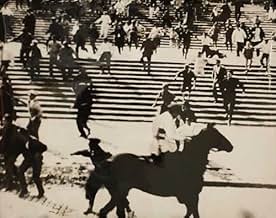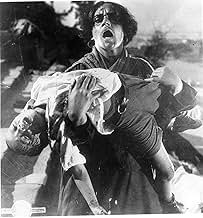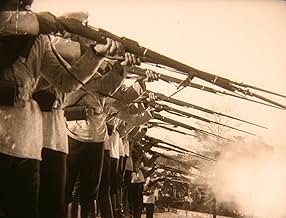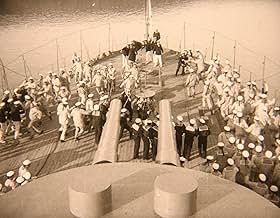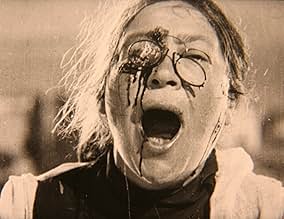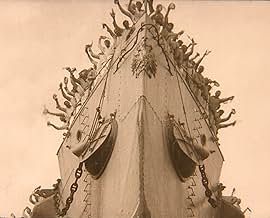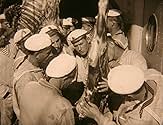IMDb रेटिंग
7.9/10
64 हज़ार
आपकी रेटिंग
1905 की रूसी क्रांति के दौरान, युद्धपोत पोटेमकिन का चालक दल पोत के अधिकारियों के क्रूर, अत्याचारी शासन के खिलाफ विद्रोह करता हैं. ओडेसा में सड़क प्रदर्शन के परिणामस्वरूप पुलिस नरसंहार होता ह... सभी पढ़ें1905 की रूसी क्रांति के दौरान, युद्धपोत पोटेमकिन का चालक दल पोत के अधिकारियों के क्रूर, अत्याचारी शासन के खिलाफ विद्रोह करता हैं. ओडेसा में सड़क प्रदर्शन के परिणामस्वरूप पुलिस नरसंहार होता है.1905 की रूसी क्रांति के दौरान, युद्धपोत पोटेमकिन का चालक दल पोत के अधिकारियों के क्रूर, अत्याचारी शासन के खिलाफ विद्रोह करता हैं. ओडेसा में सड़क प्रदर्शन के परिणामस्वरूप पुलिस नरसंहार होता है.
- पुरस्कार
- कुल 1 जीत
Ivan Bobrov
- Young Sailor Flogged While Sleeping
- (as I. Bobrov)
Nina Poltavtseva
- Woman With Pince-nez
- (as N. Poltavtseva)
Iona Biy-Brodskiy
- Student
- (as Brodsky)
Sergei Eisenstein
- Odessa Citizen
- (as Sergei M. Eisenstein)
Andrey Fayt
- Recruit
- (as A. Fait)
सारांश
Reviewers say 'Battleship Potemkin' is acclaimed for its pioneering montage and editing, significantly impacting cinema. The 1905 Russian Revolution portrayal, especially the Odessa Steps scene, is lauded for its potent visuals and emotional resonance. Many praise its technical innovations and contribution to filmmaking. However, some criticize its political propaganda and shallow character development. Nonetheless, 'Battleship Potemkin' is widely recognized as a cinematic masterpiece and a vital historical film.
फ़ीचर्ड समीक्षाएं
Originally supposed to be just a part of a huge epic The Year 1905 depicting the Revolution of 1905, Potemkin is the story of the mutiny of the crew of the Potemkin in Odessa harbor. The film opens with the crew protesting maggoty meat and the captain ordering the execution of the dissidents. An uprising takes place during which the revolutionary leader is killed. This crewman is taken to the shore to lie in state. When the townspeople gather on a huge flight of steps overlooking the harbor, czarist troops appear and march down the steps breaking up the crowd. A naval squadron is sent to retake the Potemkin but at the moment when the ships come into range, their crews allow the mutineers to pass through. Eisenstein's non-historically accurate ending is open-ended thus indicating that this was the seed of the later Bolshevik revolution that would bloom in Russia. The film is broken into five parts: Men and Maggots, Drama on the Quarterdeck, An Appeal from the Dead, The Odessa Steps, and Meeting the Squadron.
Eisenstein was a revolutionary artist, but at the genius level. Not wanting to make a historical drama, Eisenstein used visual texture to give the film a newsreel-look so that the viewer feels he is eavesdropping on a thrilling and politically revolutionary story. This technique is used by Pontecorvo's The Battle of Algiers.
Unlike Pontecorvo, Eisenstein relied on typage, or the casting of non-professionals who had striking physical appearances. The extraordinary faces of the cast are what one remembers from Potemkin. This technique is later used by Frank Capra in Mr. Deeds Goes to Town and Meet John Doe. But in Potemkin, no one individual is cast as a hero or heroine. The story is told through a series of scenes that are combined in a special effect known as montage--the editing and selection of short segments to produce a desired effect on the viewer. D.W. Griffith also used the montage, but no one mastered it so well as Eisenstein.
The artistic filming of the crew sleeping in their hammocks is complemented by the graceful swinging of tables suspended from chains in the galley. In contrast the confrontation between the crew and their officers is charged with electricity and the clenched fists of the masses demonstrate their rage with injustice.
Eisenstein introduced the technique of showing an action and repeating it again but from a slightly different angle to demonstrate intensity. The breaking of a plate bearing the words "Give Us This Day Our Daily Bread" signifies the beginning of the end. This technique is used in Last Year at Marienbad. Also, when the ship's surgeon is tossed over the side, his pince-nez dangles from the rigging. It was these glasses that the officer used to inspect and pass the maggot-infested meat. This sequence ties the punishment to the corruption of the czarist-era.
The most noted sequence in the film, and perhaps in all of film history, is The Odessa Steps. The broad expanse of the steps are filled with hundreds of extras. Rapid and dramatic violence is always suggested and not explicit yet the visual images of the deaths of a few will last in the minds of the viewer forever.
The angular shots of marching boots and legs descending the steps are cleverly accentuated with long menacing shadows from a sun at the top of the steps. The pace of the sequence is deliberately varied between the marching soldiers and a few civilians who summon up courage to beg them to stop. A close up of a woman's face frozen in horror after being struck by a soldier's sword is the direct antecedent of the bank teller in Bonnie in Clyde and gives a lasting impression of the horror of the czarist regime.
The death of a young mother leads to a baby carriage careening down the steps in a sequence that has been copied by Hitchcock in Foreign Correspondent, by Terry Gilliam in Brazil, and Brian DePalma in The Untouchables. This sequence is shown repeatedly from various angles thus drawing out what probably was only a five second event.
Potemkin is a film that immortalizes the revolutionary spirit, celebrates it for those already committed, and propagandizes it for the unconverted. It seethes of fire and roars with the senseless injustices of the decadent czarist regime. Its greatest impact has been on film students who have borrowed and only slightly improved on techniques invented in Russia several generations ago.
Eisenstein was a revolutionary artist, but at the genius level. Not wanting to make a historical drama, Eisenstein used visual texture to give the film a newsreel-look so that the viewer feels he is eavesdropping on a thrilling and politically revolutionary story. This technique is used by Pontecorvo's The Battle of Algiers.
Unlike Pontecorvo, Eisenstein relied on typage, or the casting of non-professionals who had striking physical appearances. The extraordinary faces of the cast are what one remembers from Potemkin. This technique is later used by Frank Capra in Mr. Deeds Goes to Town and Meet John Doe. But in Potemkin, no one individual is cast as a hero or heroine. The story is told through a series of scenes that are combined in a special effect known as montage--the editing and selection of short segments to produce a desired effect on the viewer. D.W. Griffith also used the montage, but no one mastered it so well as Eisenstein.
The artistic filming of the crew sleeping in their hammocks is complemented by the graceful swinging of tables suspended from chains in the galley. In contrast the confrontation between the crew and their officers is charged with electricity and the clenched fists of the masses demonstrate their rage with injustice.
Eisenstein introduced the technique of showing an action and repeating it again but from a slightly different angle to demonstrate intensity. The breaking of a plate bearing the words "Give Us This Day Our Daily Bread" signifies the beginning of the end. This technique is used in Last Year at Marienbad. Also, when the ship's surgeon is tossed over the side, his pince-nez dangles from the rigging. It was these glasses that the officer used to inspect and pass the maggot-infested meat. This sequence ties the punishment to the corruption of the czarist-era.
The most noted sequence in the film, and perhaps in all of film history, is The Odessa Steps. The broad expanse of the steps are filled with hundreds of extras. Rapid and dramatic violence is always suggested and not explicit yet the visual images of the deaths of a few will last in the minds of the viewer forever.
The angular shots of marching boots and legs descending the steps are cleverly accentuated with long menacing shadows from a sun at the top of the steps. The pace of the sequence is deliberately varied between the marching soldiers and a few civilians who summon up courage to beg them to stop. A close up of a woman's face frozen in horror after being struck by a soldier's sword is the direct antecedent of the bank teller in Bonnie in Clyde and gives a lasting impression of the horror of the czarist regime.
The death of a young mother leads to a baby carriage careening down the steps in a sequence that has been copied by Hitchcock in Foreign Correspondent, by Terry Gilliam in Brazil, and Brian DePalma in The Untouchables. This sequence is shown repeatedly from various angles thus drawing out what probably was only a five second event.
Potemkin is a film that immortalizes the revolutionary spirit, celebrates it for those already committed, and propagandizes it for the unconverted. It seethes of fire and roars with the senseless injustices of the decadent czarist regime. Its greatest impact has been on film students who have borrowed and only slightly improved on techniques invented in Russia several generations ago.
I don't recommend that you see this as a 'landmark' in film; don't merely pass through to say you did, or because it's a travelled destination for most people. Instead, come to this with fresh eyes if you can. Rarely since has a film - and film tradition - been so deeply centered within its worldview, rarely indeed is a film made of the very fabric of the world it gives voice to. Most films these days are built at random, or from random spare parts.
Eisenstein had already made a more successful film before this, more reflexively about the seeing eye. So, even though there is a more rip-roaring story here, you may have to struggle a bit with how faceless appears this world to us, these days so accustomed to the paradigm of the individual hero. But Eisenstein was an architect - literally, as well as in film - and so space matters, our relationship with space through motion matters.
In other words; this may have been preserved to us as a museum piece, which is an indictment of our own understanding of cinema as coming down to us by the books and lists of assorted institutions, but at the time it was part of the most deeply revolutionary film school, one that rigged trains as movie studios and sent them scurrying the countryside to film the people and show them to themselves. I mean, here was a man - Eisenstein - who studied Japanese ideograms to understand synthesized image; who discovered that editing to the beats of the human heart affected more, true or false it shows the desire to both know and reach out.
Our cinematic ideas have mostly regressed into mechanical reproduction since the time when these things were first engineered. Oh, there's plenty of Eisenstein every time you open the TV, but none of it is knowing. It's merely a matter of going-through-the-motions, without the blueprint anymore.
So, look at how crowds are orchestrally conducted through stark geometries, how Eisenstein dissects cinematic space with even a stationary camera. But this type of cinema meant to agitate the people, was never about a thought, it was about an action.
And so with this one. There is the one hero who, although dead, calls out to the people. They rush to him, like ships around their harbor. So on board the ship there is valiant effort for brotherhood and justice, inspired revolution; portside is the motherland, cheering the effort with aplomb. And in the end there is the hero ship, itself filled with heroes, now passing through a sea corridor lined with brother ships, all cheering the one. You can imagine the people cheering at the cinema, who had been there to cheer the real thing years ago.
And when I say 'the real thing' I mean the revolution 8 years before; the Potemkin event depicted here was purely fictional. Yet by the famous steps at Odessa is erected a monument to the fictional sailors, what better example of cinema shaping reality?
So yes, it is a revolutionary film. We may be inclined to make fun of the notions, or worse yet dismiss off-hand because of hindsight knowledge. But this was a film celebrating a time when the world seemed like it could be new again. Then came Stalin and, ironically, vanished all these filmmakers that sung the paeans.
Eisenstein had already made a more successful film before this, more reflexively about the seeing eye. So, even though there is a more rip-roaring story here, you may have to struggle a bit with how faceless appears this world to us, these days so accustomed to the paradigm of the individual hero. But Eisenstein was an architect - literally, as well as in film - and so space matters, our relationship with space through motion matters.
In other words; this may have been preserved to us as a museum piece, which is an indictment of our own understanding of cinema as coming down to us by the books and lists of assorted institutions, but at the time it was part of the most deeply revolutionary film school, one that rigged trains as movie studios and sent them scurrying the countryside to film the people and show them to themselves. I mean, here was a man - Eisenstein - who studied Japanese ideograms to understand synthesized image; who discovered that editing to the beats of the human heart affected more, true or false it shows the desire to both know and reach out.
Our cinematic ideas have mostly regressed into mechanical reproduction since the time when these things were first engineered. Oh, there's plenty of Eisenstein every time you open the TV, but none of it is knowing. It's merely a matter of going-through-the-motions, without the blueprint anymore.
So, look at how crowds are orchestrally conducted through stark geometries, how Eisenstein dissects cinematic space with even a stationary camera. But this type of cinema meant to agitate the people, was never about a thought, it was about an action.
And so with this one. There is the one hero who, although dead, calls out to the people. They rush to him, like ships around their harbor. So on board the ship there is valiant effort for brotherhood and justice, inspired revolution; portside is the motherland, cheering the effort with aplomb. And in the end there is the hero ship, itself filled with heroes, now passing through a sea corridor lined with brother ships, all cheering the one. You can imagine the people cheering at the cinema, who had been there to cheer the real thing years ago.
And when I say 'the real thing' I mean the revolution 8 years before; the Potemkin event depicted here was purely fictional. Yet by the famous steps at Odessa is erected a monument to the fictional sailors, what better example of cinema shaping reality?
So yes, it is a revolutionary film. We may be inclined to make fun of the notions, or worse yet dismiss off-hand because of hindsight knowledge. But this was a film celebrating a time when the world seemed like it could be new again. Then came Stalin and, ironically, vanished all these filmmakers that sung the paeans.
A milestone in cinematic history, 'Bronenosets Potyomkin' is one of the handful of great films out there that richly deserves to be called a classic. It was the picture that made Sergei M. Eisenstein a figurehead of film-making at the time. And today, it is still remembered as the wonderful piece of cinema it always has been.
'Potyomkin' is a film that NEEDS to be seen as one entity, not to be picked at. Don't just watch those clip shows where they only present the 'Odessa steps' sequence and then move on to 'Citizen Kane' or 'The Godfather', see it all in it's glorious 75-minute running time to really understand and enjoy it. Don't expect every infinitesimal detail to be perfect though, I mean the acting of the '20s silent era makes 'Scooby Doo' look like a master of understated realism, certain plot points may seem illogical and some of the battle sequences look dated, but it is still an immensely enjoyable movie.
The most memorable moments in the film are the mutiny on the battleship, Vakulinchuk's body falling off the ship, the sailor under the tent at the end of the pier, the mother holding her dead child, the baby carriage on the Odessa steps and the lion rising up to roar as further carnage ensues. For each new pair of eyes that look upon it, 'The Battleship Potemkin' comes alive once again.
'Potyomkin' is a film that NEEDS to be seen as one entity, not to be picked at. Don't just watch those clip shows where they only present the 'Odessa steps' sequence and then move on to 'Citizen Kane' or 'The Godfather', see it all in it's glorious 75-minute running time to really understand and enjoy it. Don't expect every infinitesimal detail to be perfect though, I mean the acting of the '20s silent era makes 'Scooby Doo' look like a master of understated realism, certain plot points may seem illogical and some of the battle sequences look dated, but it is still an immensely enjoyable movie.
The most memorable moments in the film are the mutiny on the battleship, Vakulinchuk's body falling off the ship, the sailor under the tent at the end of the pier, the mother holding her dead child, the baby carriage on the Odessa steps and the lion rising up to roar as further carnage ensues. For each new pair of eyes that look upon it, 'The Battleship Potemkin' comes alive once again.
Sergei Eisenstein's silent masterpiece is a very influential and possibly the most famous landmark film ever made. Many, many memorable scenes, including one of the best and most powerful scenes in film history, the massacre on the Odessa steps. No film in our time has captured such power and amazement from one sequence. Along from being a landmark in film history, it also has a strong message on brotherhood and power hungry leaders. This one has stood the test of time and will for ever more.
This classic is filled with vivid images that stay in your mind after you have watched it, and there is a lot to appreciate in the way that the key scenes were set up and photographed. The visuals are so impressive that the movie's imperfections are usually not so noticeable, and they don't keep it from being a memorable film.
The movie certainly deserves the praise that it gets both for the influence that it has had, and for some ideas that for the time were most creative. The famed 'Odessa Steps' sequence alone demonstrates both fine technical skill and a keen awareness of how to drive home an image to an audience. It deserves to be one of cinema's best remembered sequences. Some of the other scenes also demonstrate, to a lesser degree, the same kind of skill.
It says a lot for how effective all of the visuals are that so many viewers think so highly of "Battleship Potemkin" despite a story that is sometimes heavy-handed, and despite characters and acting that are both rather thin. These features might simply stem from the collectivist philosophy that lies behind the story, and they are obscured most of the time by Eisenstein's unsurpassed ability to present pictures that viewers will not forget.
Despite the flaws, this is a movie that most fans of silent films, and anyone interested in the history of movies, will want to see. There's nothing else in its era that's quite like it.
The movie certainly deserves the praise that it gets both for the influence that it has had, and for some ideas that for the time were most creative. The famed 'Odessa Steps' sequence alone demonstrates both fine technical skill and a keen awareness of how to drive home an image to an audience. It deserves to be one of cinema's best remembered sequences. Some of the other scenes also demonstrate, to a lesser degree, the same kind of skill.
It says a lot for how effective all of the visuals are that so many viewers think so highly of "Battleship Potemkin" despite a story that is sometimes heavy-handed, and despite characters and acting that are both rather thin. These features might simply stem from the collectivist philosophy that lies behind the story, and they are obscured most of the time by Eisenstein's unsurpassed ability to present pictures that viewers will not forget.
Despite the flaws, this is a movie that most fans of silent films, and anyone interested in the history of movies, will want to see. There's nothing else in its era that's quite like it.
क्या आपको पता है
- ट्रिवियाThe film censorship boards of several countries felt this movie would spread communism. France imposed a ban after a brief run in 1925; it lifted it in 1953 after the death of Russian leader Joseph Stalin. The UK banned it until 1954.
- गूफ़In the Imperial squadron near the end of the film, there are close-ups of triple gun turrets of Gangut-class dreadnought. It possibly was made this way to show the power of Imperial fleet, but battleships of 1905 were much smaller pre-dreadnoughts, with twin turrets only, just like "Potemkin". "Ganguts" entered service in 1914.
- इसके अलावा अन्य वर्जनSergei Eisenstein's premiere version opened with an unattributed quote from Leon Trotsky's "1905": The spirit of mutiny swept the land. A tremendous, mysterious process was taking place in countless hearts: the individual personality became dissolved in the mass, and the mass itself became dissolved in the revolutionary impetus. This quote was removed by Soviet censors in 1934, and replaced by a quotation from V.I. Lenin's "Revolutionary Days": Revolution is war. Of all the wars known in history, it is the only lawful, rightful, just and truly great war...In Russia this war has been declared and won. The original text was restored in 2004.
- कनेक्शनEdited into Seeds of Freedom (1943)
टॉप पसंद
रेटिंग देने के लिए साइन-इन करें और वैयक्तिकृत सुझावों के लिए वॉचलिस्ट करें
- How long is Battleship Potemkin?Alexa द्वारा संचालित
विवरण
- रिलीज़ की तारीख़
- कंट्री ऑफ़ ओरिजिन
- भाषाएं
- इस रूप में भी जाना जाता है
- Battleship Potemkin
- फ़िल्माने की जगहें
- Sevastopol, Crimea, युक्रेन(battleship scenes)
- उत्पादन कंपनी
- IMDbPro पर और कंपनी क्रेडिट देखें
बॉक्स ऑफ़िस
- US और कनाडा में सकल
- $51,198
- US और कनाडा में पहले सप्ताह में कुल कमाई
- $5,641
- 16 जन॰ 2011
- दुनिया भर में सकल
- $62,723
- चलने की अवधि
- 1 घं 15 मि(75 min)
- रंग
- ध्वनि मिश्रण
- पक्ष अनुपात
- 1.33 : 1
इस पेज में योगदान दें
किसी बदलाव का सुझाव दें या अनुपलब्ध कॉन्टेंट जोड़ें


